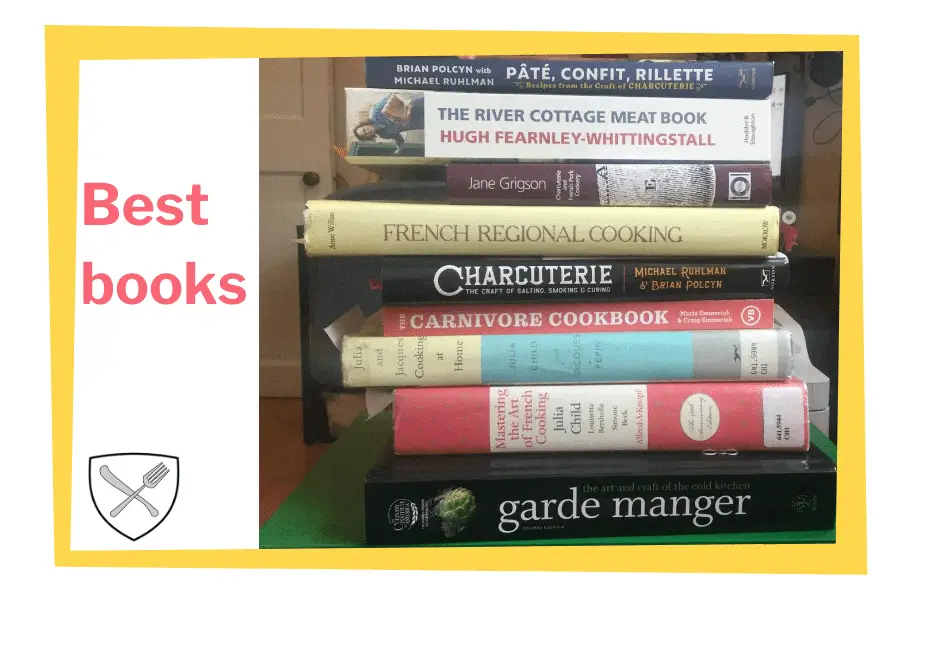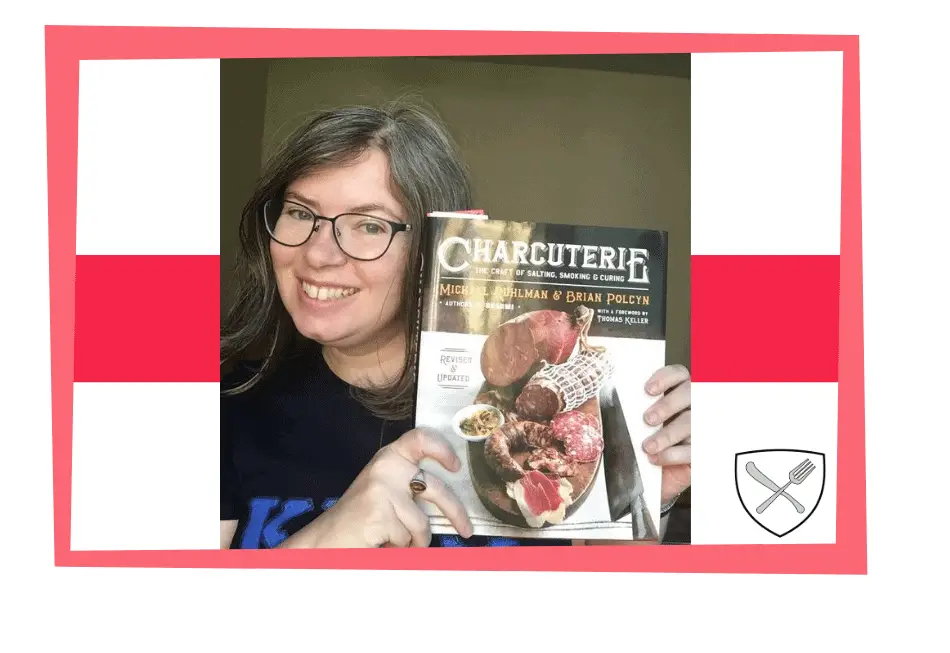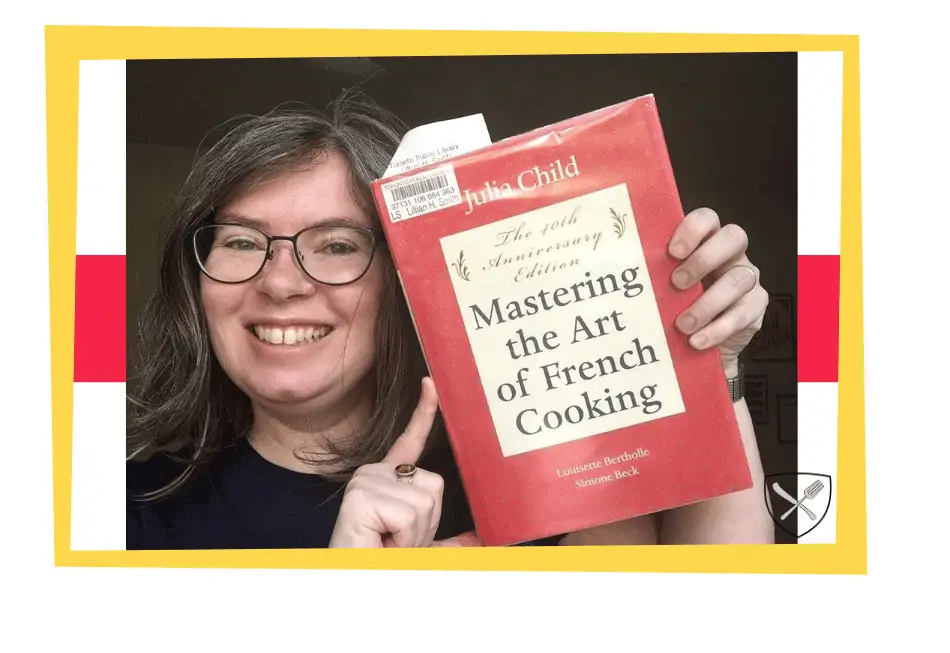
The Best Cookbooks for Pâtés, Terrines, Charcuterie and Other French Cooking
Even as the term plant-based has exploded in the past few years, so has the interest in traditional, meat-based foods. This means it’s easy to become overwhelmed at the bookstore by all the cookbook options calling to you. To write the articles on this site, my research goes beyond the internet and into the world of books and I’ve explored a whole bunch of them.
Today, I want to tell you which ones are worth buying and why.
I’ll go into each pick in detail but the short version is this: For making pâtés, choose Pâté, Confit, Rillette: Recipes from the Craft of Charcuterie by Brian Polcyn and Michael Ruhlman (click here to see it on Amazon).
For charcuterie, like making salami, corned beef, etc., choose Charcuterie: The Craft of Salting, Smoking & Curing by Michael Ruhlman and Brian Polcyn (click here to see it on Amazon).
And for all-around French cooking, choose Mastering the Art of French Cooking, The 50th Anniversary Edition by Julia Child (click here to see it on Amazon).
Let’s go through them one by one.
Best cookbook for pâtés, rillettes etc.: Pâté, Confit, Rillette: Recipes from the Craft of Charcuterie by Brian Polcyn and Michael Ruhlman

If you’re serious about making pâtés, rilllettes and confit, you only need one book: Pâté, Confit, Rillette: Recipes from the Craft of Charcuterie by Brian Polcyn and Michael Ruhlman (click here to see it on Amazon).
It’s well laid out, concepts and techniques are explained clearly, it’s got beautiful pictures on glossy pages and their chicken liver terrine—which feels like a mousse—is like eating a piece of heaven. That recipe is so good, it even works when you screw up (like I did the first time I made it).
As for the price, it’s in the $40-$50 range which is average for a decently sized glossy cookbook.
This book might scare you at first, like it did to me. I first got this book from the library during the beginning of my exploration into forcemeat. I was almost scared off by the chapter on pâté en terrine; Brian and Michael are persnickety about sharp tools, meat grinders and keeping everything exactly cold enough. I don’t have a meat grinder, stand mixer or tamis, I’m not precise when it comes to cooking and the sharpest my knives get are not quite dull.
I wondered if this was a hopeless area of exploration.
But then two things happened: I made that chicken liver terrine recipe (forgetting to cover the terrine with foil) and it turned out amazingly. This recipe is basically liver, whip cream and wine so none of those essential tools are required.
Then I looked at other pâté recipes online and found that many of them call for ground meat instead of grinding it yourself. I decided I didn’t need to be scared of the best practices in this book; instead I could work up to them as skills and equipment allow.
And since then, I’ve been making other recipes in the book and they’ve all turned out well. Plus, I’m learning so much from it (which I share with you in articles).
The other thing I like about this book is it includes gluten-free pâté recipes. Some recipes call for flour or bread (which I don’t eat) but others are gluten-free by design which means I can try them and not worry about substitutions.
A real chef could pick up this book and be pleased with the results. But Michael and Brian have written it so that home chefs, unfamiliar with this style of cooking can also succeed. Which is an amazing accomplishment!
If you’re getting into forcemeat, this should be the first book you buy. You might love it so much that you never buy another cookbook.
And that’s about all I have to say on the excellent book, Pâté, Confit, Rillette: Recipes from the Craft of Charcuterie by Brian Polcyn and Michael Ruhlman (click here to see it on Amazon).
May your chicken liver terrine always be heavenly!
Best cookbook for charcuterie: Charcuterie: The Craft of Salting, Smoking & Curing by Michael Ruhlman and Brian Polcyn

If you’re serious about charcuterie—salami, sausage and Carolina-style smoked barbeque—you need the Holy Grail of charcuterie: Charcuterie: The Craft of Salting, Smoking & Curing by Brian Polcyn and Michael Ruhlman (click here to see it on Amazon).
This recommendation is based on research not my own personal success with the recipes. I own the book and I use it for research, but I just haven’t moved into charcuterie yet. But because I know the quality content that Brian Polcyn and Michael Ruhlman produce, I don’t hesitate to recommend it.
About Charcuterie: The Craft of Salting, Smoking & Curing, regular home cooks have said:
- This is the bible of charcuterie.
- This book is by far the holy grail when it comes to charcuterie!!
- This is a wonderful book on charcuterie for the beginner, intermediate and advanced chef.
- Excellent book with good introduction to charcuterie and endless recipes to try. The ones I’ve tried have to my astonishment worked well. (Not a very experienced cook!)
- Probably one of the best books I have read on charcuterie. Certainly given me the confidence to try a few new things.
Plus the back of the book has glowing reviews from these top chefs and foodies:
- Thomas Keller.
- Anthony Bourdain.
- Eric Rupert.
- Lynne Rossetto Kasper.
- Mario Batali.
- Paul Bertolli.
- Judy Rodgers.
This book covers an introduction to each technique, principles of the technique and recipes for:
- Salt-cured food.
- Smoked food.
- Sausages.
- Dry-cured food.
- Pâtés and terrines.
- Confit.
- Sauces and condiments.
One warning about this book: This is not a glossy, food-porn type of cookbook. It’s jam packed with text and the pictures included are drawings. However, for the Holy Grail and Bible of charcuterie, this seems appropriate.
And that’s about all I have to say—for now—on this super helpful and educational book, Charcuterie: The Craft of Salting, Smoking & Curing by Brian Polcyn and Michael Ruhlman (click here to see it on Amazon).
May your salamis always be blessed with the good molds, not the bad ones!
Best cookbook for all-around French cooking: Mastering the Art of French Cooking, The 50th Anniversary Edition by Julia Child

If you’re serious about producing food worthy of a French bistro in your own kitchen, you’ll want to invest in the perennial bestseller, first published in 1961, Mastering the Art of French Cooking, The 50th Anniversary Edition by Julia Child (click here to see it on Amazon).
This recommendation was first based on research, then on personal experience after buying the book. I’m learning a lot from it, even though I first was just paying attention to the meat-based recipes.
And that’s the gist of this book; it’s all about learning for the purpose of enjoyment at the dinner table.
As Julia and her co-authors, Louisette Bertholle and Simone Beck, say in the foreword of their book, “This is a book for the servantless American cook who can be unconcerned on occasion with budgets, waistlines, time schedules, children’s meals, the parent-chauffeur-den-mother syndrome, or anything else which might interfere with the enjoyment of producing something wonderful to eat.”
The recipes in this book aren’t laid out like you see in a modern cookbook. Instead, the ingredients are on the left side of the page and the instructions for what to do with those ingredients are laid out to the right of those ingredients. Then it goes to the next set of ingredients and steps, sometimes with a big gap of white space on the instruction side of the page.
This is quite genius though it might take some getting used to. Plus, it makes some of the recipes seem longer than they actually are.
Julia warns the reader to not skip steps in the recipe—because they are each there for a reason. However, she goes on to say that once you master the basics—which are taught in this almost 700-page book—you’ll rely on recipes less and less.
Mastering the Art of French Cooking covers:
- Equipment, definitions, measures, temperatures, cutting and wines.
- Soups.
- Sauces.
- Eggs.
- Entrées and luncheon dishes.
- Fish.
- Poultry.
- Meat.
- Vegetables.
- Cold buffet which includes mousses, aspics, pâtés and terrines.
- Desserts and cakes.
If you’ve made your way to Forcemeat Academy because of a broader interest in French food, you’ll love this book.
I must warn you that this book is for reading and doing, not for gazing at lovingly. There are black and white drawings to demonstrate techniques, tools and some ingredients but there are no glossy pictures. However, this seems completely appropriate for the seminal work on French cooking.
Maybe my experience with the book, first from the library, then from buying it myself, isn’t enough for you. That’s okay. Let me leave you with these thoughts from Nora Ephron, the hilarious wordsmith who wrote and directed the movie, Julie & Julia.
In a 2009 interview with NPR, Nora said, “I followed so many Julia Child recipes. I was a slave to Julia when I got that book, and all of my friends were. This was in the ’60s when I was young, and the book had just come out. And truly, if you didn’t own that book, you had not passed into adulthood as we understood it in those days. Everybody cooked from it. It worked. It was perfect. And I learned to cook from that cookbook, and, what’s more, became completely infatuated with the person who’d written it.”
Nora also revealed her favourite recipes (which were featured in the movie). She said, “One of them is chicken breasts with cream and port and mushrooms, which is heavenly and takes only about, really, 28 minutes to make. And that’s great. And then the classic lamb stew recipe, which – there’s no better recipe, period. That’s the end of that. And I love lamb stew. Love it.”
And while there’s a lot more that could be said about this book, I’ll leave it at that for now. If cooking French food is on your wish list, go get Mastering the Art of French Cooking, The 50th Anniversary Edition by Julia Child (click here to see it on Amazon).
May your chicken breasts always be heavenly with cream, port and mushrooms!
Click here to see my recommendations for the best terrines and click here to see the resource page for animal-foods based nutrition.
Important legal notice: This post contains affiliate links. I’m compensated for many of my product recommendations. Forcemeat Academy is a participant in the Amazon Associates affiliate program, as well as other affiliate programs. While I’m careful to only recommend the products I use and love, I want to be open and transparent about the relationship I have with companies I recommend.